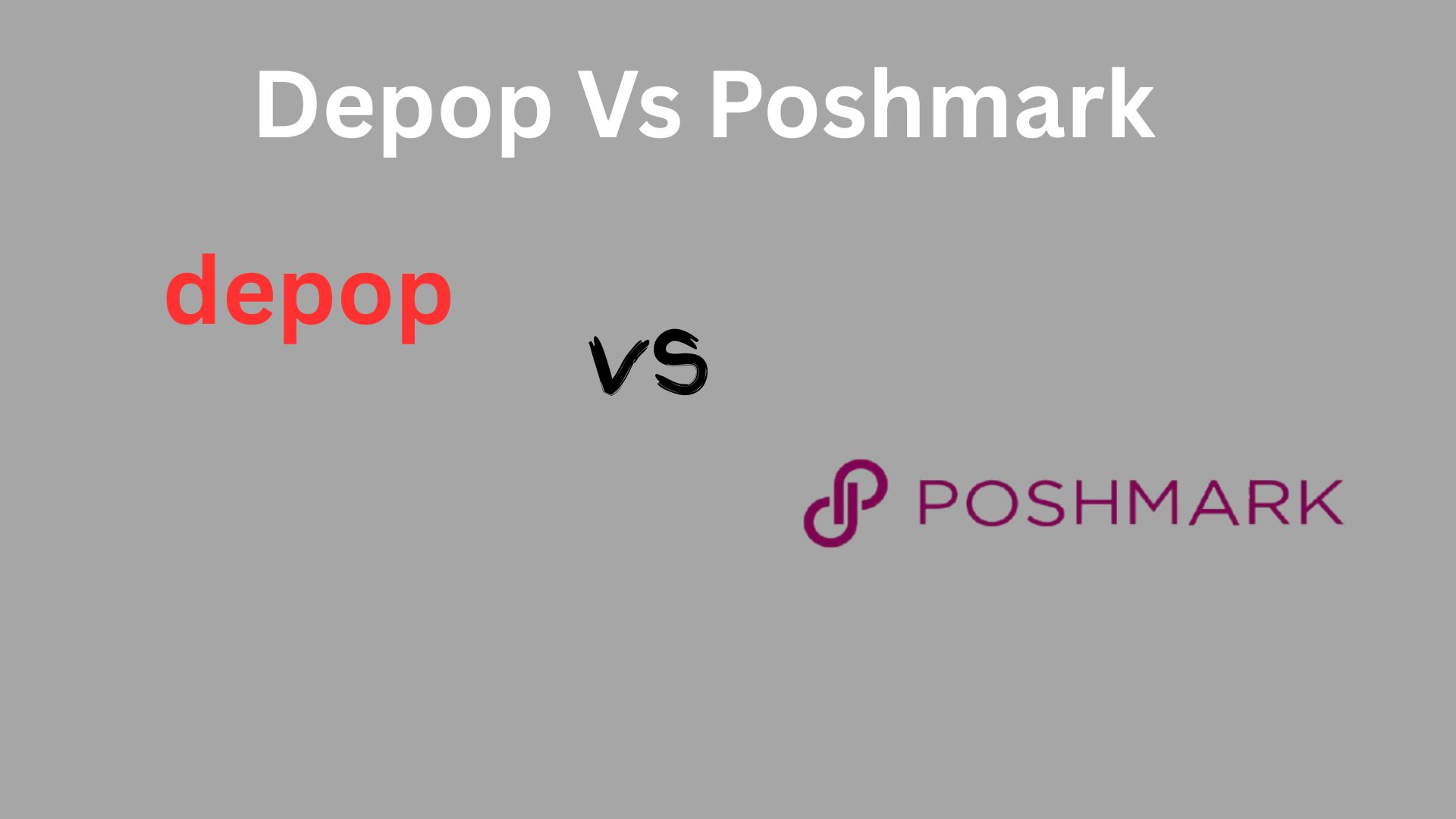In the world of online fashion resale, two names frequently come up: Depop and Poshmark. These platforms have transformed the way people buy and sell secondhand clothing, making it easier than ever to turn pre-loved items into cash. But when it comes to choosing between them, which platform is best? If you’re a seller looking to start an online resale business or a buyer hunting for unique fashion pieces, understanding the differences between Depop and Poshmark is essential.
This in-depth guide will compare Depop vs Poshmark, analyzing key aspects like fees, shipping, audience, listing processes, and seller experiences. Whether you’re looking to resell vintage streetwear on Depop or sell designer pieces on Poshmark, this article will help you make an informed decision.
Key Takeaways
- Depop and Poshmark are two of the most popular platforms for selling fashion items, but they cater to different audiences and selling styles.
- Depop is a social media-driven marketplace, popular among Gen Z and focused on trendy, vintage, and streetwear fashion.
- Poshmark is a social commerce platform with a broader audience, ideal for selling name-brand and luxury items.
- Fees and shipping methods differ: Poshmark offers a prepaid shipping label but takes a flat rate commission, whereas Depop takes 10% of the sale price but allows sellers more flexibility with shipping.
- Choosing Depop or Poshmark depends on what you’re selling, your pricing strategy, and how much effort you’re willing to put into marketing your items.
This guide will break down the comparison of Depop vs Poshmark in detail, ensuring you have all the information to decide which platform is best for your needs.
Depop vs Poshmark: Platform Overview and Audience
What is Depop?

Depop is a social media-driven marketplace designed for buying and selling secondhand fashion. It operates much like Instagram, where users can create visually appealing storefronts, engage with buyers through comments and messages, and promote their listings through hashtags and the platform’s algorithm. Depop primarily caters to Gen Z and millennials who are interested in unique, vintage, and trendy clothing.
Key Features of Depop:
- Social Commerce: Depop emphasizes interaction, allowing users to like, comment, and follow sellers.
- Niche Market: Ideal for streetwear, Y2K fashion, vintage clothing, and handmade items.
- Flexible Shipping: Depop allows sellers to create their own shipping policies or use Depop-provided shipping labels.
- Payment Processing: Depop allows direct payments via PayPal or Depop’s in-app system.
What is Poshmark?

Poshmark is a social commerce platform where users can buy and sell clothing, accessories, and even home goods. Unlike Depop, which focuses on a youthful, trend-driven audience, Poshmark tends to attract a slightly older demographic, including professionals and resellers looking for high-end fashion and well-known brands.
Key Features of Poshmark:
- Prepaid Shipping: Sellers receive a prepaid shipping label for easy order fulfillment.
- Poshmark Parties: Live shopping events where sellers can promote listings in themed virtual events.
- Higher-End Market: Poshmark makes it easy to sell designer brands and luxury items.
- Social Selling: Users share and promote listings for increased visibility.
Audience Comparison: Who Shops on Depop vs Poshmark?
| Feature | Depop | Poshmark |
|---|---|---|
| Primary Audience | Gen Z & Millennials | Millennials & Gen X |
| Popular Items | Vintage, streetwear, indie fashion | Designer brands, name brands, workwear |
| User Experience | Feels like a social media platform | More structured and traditional marketplace |
| Best For | Selling unique and trendy pieces | Selling premium and luxury brands |
Understanding the differences between Depop and Poshmark in terms of audience and platform style is crucial for sellers who want to maximize their sales. If you’re targeting young, trend-conscious buyers, use Depop. If you prefer a structured platform with built-in promotional tools, Poshmark offers better opportunities.
Depop vs Poshmark: Fees, Shipping, and Selling Process
Fees and Commissions: How Much Do Depop and Poshmark Take?
One of the biggest considerations when choosing between Depop vs Poshmark is the cost of selling. Both platforms charge fees, but they differ in structure.
Depop Fees
- Depop takes 10% of the final sale price (excluding shipping).
- Payment Processing Fee: 2.9% + $0.30 per transaction for U.S. sales (varies by country).
- No listing fee, meaning you can post as many items as you want for free.
- Depop payments can be received via PayPal or directly into a bank account.
Poshmark Fees
- Poshmark takes a flat fee of $2.95 for sales under $15.
- For items priced at $15 or more, Poshmark charges a 20% commission.
- No additional payment processing fees.
- Funds are available in the seller’s account after the buyer confirms the item was received.
Shipping on Depop vs Poshmark
Shipping is another key difference in the comparison of Depop vs Poshmark. The platforms handle shipping in distinct ways, affecting convenience and cost.
Depop Shipping
- Depop offers sellers the option to either use a prepaid shipping label (provided by Depop) or set their own shipping prices.
- Shipping costs vary depending on item weight and location.
- Ship with Depop for convenience, or choose your own carrier to save costs.
Poshmark Shipping
- Poshmark simplifies the process by providing a prepaid shipping label for all sales.
- Flat rate shipping fee of $7.97 for most items, paid by the buyer.
- The prepaid label covers packages up to 5 lbs; additional fees apply for heavier items.
Selling Process: Listing and Making Sales
The ease of listing items and closing sales varies between the two platforms.
Listing on Depop
- Depop allows sellers to create visually appealing listings with up to 4 images.
- Users can add hashtags, descriptions, and set their own prices.
- Depop work more like a social media platform, meaning engagement (likes, comments, shares) can boost visibility.
- Sellers must actively promote their items to drive sales.
Listing on Poshmark
- Poshmark listings require high-quality photos and detailed descriptions.
- Poshmark users rely on Poshmark Parties and sharing features to get exposure.
- Items can take longer to sell due to the platform’s reliance on social sharing.
When deciding whether to sell on Depop vs Poshmark, sellers should consider both fees and ease of use. Depop provides more flexibility, while Poshmark simplifies shipping and offers built-in promotion tools.
Depop vs Poshmark: Pros And Cons
Pros and Cons of Selling on Depop vs Poshmark
When comparing Depop vs Poshmark, understanding the advantages and limitations of each platform can help you decide where to list your items.
Pros and Cons of Depop
Pros:
- Social media-driven marketplace that appeals to younger buyers.
- Depop allows direct payments through PayPal or bank transfers.
- Lower selling fees (10% commission compared to Poshmark’s 20%).
- Greater flexibility in shipping on Depop, allowing sellers to choose their own method.
- Ideal for vintage, indie, and streetwear fashion.
Cons:
- Requires active engagement to make sales on Depop.
- Less buyer protection compared to Poshmark’s structured system.
- Shipping costs and logistics must be handled carefully by sellers.
- Some buyers and sellers experience scams due to less stringent protections.
Pros and Cons of Poshmark
Pros:
- Poshmark simplifies shipping with prepaid shipping labels.
- Stronger buyer and seller protection policies.
- Poshmark sellers can leverage Poshmark Parties to increase visibility.
- Easier for selling luxury or high-end brands due to a well-established trust system.
- No listing fees and a straightforward selling process.
Cons:
- Poshmark takes a higher commission (20% on items over $15).
- Poshmark also requires sellers to engage in social sharing to boost visibility.
- Flat rate shipping may not be ideal for lower-cost items.
- Not as appealing for niche, streetwear, or alternative fashion styles.
Final Verdict- Which Platform is Best for You?
The choice between Depop or Poshmark depends on what you’re selling and how much effort you want to put into marketing your items.
- Use Depop if you’re selling trendy, vintage, or handmade fashion and prefer a social media platform approach to marketing your items.
- Poshmark offers a more structured system, making it ideal for resale of name-brand, luxury, and designer goods.
- If you want lower selling fees and flexible shipping, Depop provides more control.
- If you prefer prepaid shipping labels and stronger buyer protections, Poshmark simplifies the process.
Both platforms offer unique advantages, so choosing between Depop and Poshmark ultimately depends on your business model and target audience. If possible, consider cross-listing on both platforms to maximize sales potential.
Explore More Articles
FAQs: Depop vs Poshmark
1. Which platform is better for selling secondhand clothing, Depop or Poshmark?
Both Depop and Poshmark are great for selling secondhand clothing, but they cater to different audiences. Depop is best for trendy, vintage, and streetwear fashion, while Poshmark is better for brand-name and luxury clothing.
2. What are the selling fees on Depop vs Poshmark?
- Depop takes 10% of the final sale price, plus a small payment processing fee.
- Poshmark takes $2.95 on sales under $15 and 20% on sales over $15.
3. How does shipping work on Depop vs Poshmark?
- Depop allows sellers to set their own shipping prices or use Depop’s prepaid shipping labels.
- Poshmark simplifies shipping by providing a prepaid shipping label for every order, but it has a flat shipping rate of $7.97 for most items.
4. Is Depop or Poshmark better for selling designer brands?
Poshmark is best for selling high-end and luxury brands because it has built-in authentication services and a larger audience for premium items.
5. Can I use both Depop and Poshmark to sell my items?
Yes! Many sellers cross-list items on both platforms to increase their chances of making a sale. However, make sure to remove listings on one platform once the item sells on the other.
6. Does Depop or Poshmark offer buyer and seller protection?
- Depop provides buyer protection through PayPal and its in-app payment system, but it relies more on users to resolve disputes.
- Poshmark offers stronger buyer and seller protections, holding funds until the buyer confirms receipt of the item.
7. Which platform is easier for new sellers to use?
- Poshmark simplifies the process with easy listing tools, prepaid shipping, and built-in promotion.
- Depop allows more customization but requires sellers to be more active in marketing their items.
8. Which platform has a larger audience?
Poshmark has a larger audience in the U.S. and Canada, while Depop is popular internationally, especially among younger buyers interested in unique and vintage fashion.
Choosing Depop vs Poshmark depends on your selling strategy and target audience. If possible, using both platforms can help maximize your sales!




